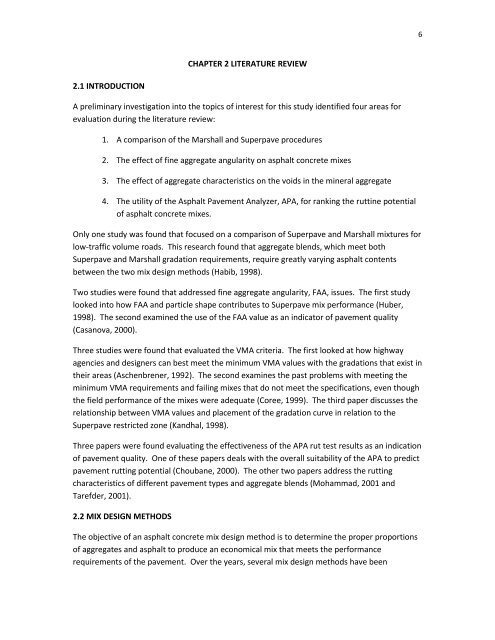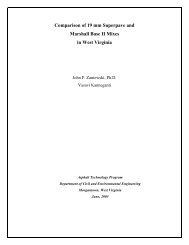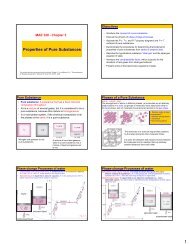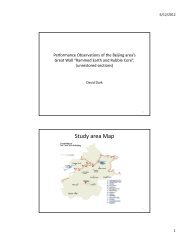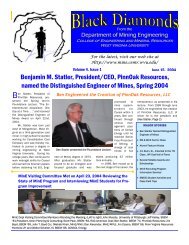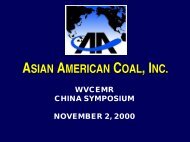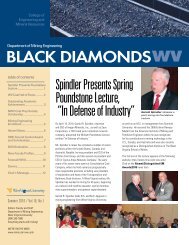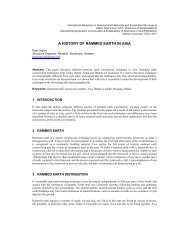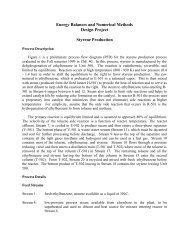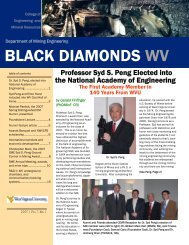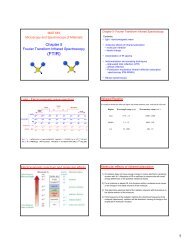Comparison of 9.5 mm SuperPave and Marshall Wearing I Mixes in ...
Comparison of 9.5 mm SuperPave and Marshall Wearing I Mixes in ...
Comparison of 9.5 mm SuperPave and Marshall Wearing I Mixes in ...
You also want an ePaper? Increase the reach of your titles
YUMPU automatically turns print PDFs into web optimized ePapers that Google loves.
6CHAPTER 2 LITERATURE REVIEW2.1 INTRODUCTIONA prelim<strong>in</strong>ary <strong>in</strong>vestigation <strong>in</strong>to the topics <strong>of</strong> <strong>in</strong>terest for this study identified four areas forevaluation dur<strong>in</strong>g the literature review:1. A comparison <strong>of</strong> the <strong>Marshall</strong> <strong>and</strong> Superpave procedures2. The effect <strong>of</strong> f<strong>in</strong>e aggregate angularity on asphalt concrete mixes3. The effect <strong>of</strong> aggregate characteristics on the voids <strong>in</strong> the m<strong>in</strong>eral aggregate4. The utility <strong>of</strong> the Asphalt Pavement Analyzer, APA, for rank<strong>in</strong>g the rutt<strong>in</strong>e potential<strong>of</strong> asphalt concrete mixes.Only one study was found that focused on a comparison <strong>of</strong> Superpave <strong>and</strong> <strong>Marshall</strong> mixtures forlow-traffic volume roads. This research found that aggregate blends, which meet bothSuperpave <strong>and</strong> <strong>Marshall</strong> gradation requirements, require greatly vary<strong>in</strong>g asphalt contentsbetween the two mix design methods (Habib, 1998).Two studies were found that addressed f<strong>in</strong>e aggregate angularity, FAA, issues. The first studylooked <strong>in</strong>to how FAA <strong>and</strong> particle shape contributes to Superpave mix performance (Huber,1998). The second exam<strong>in</strong>ed the use <strong>of</strong> the FAA value as an <strong>in</strong>dicator <strong>of</strong> pavement quality(Casanova, 2000).Three studies were found that evaluated the VMA criteria. The first looked at how highwayagencies <strong>and</strong> designers can best meet the m<strong>in</strong>imum VMA values with the gradations that exist <strong>in</strong>their areas (Aschenbrener, 1992). The second exam<strong>in</strong>es the past problems with meet<strong>in</strong>g them<strong>in</strong>imum VMA requirements <strong>and</strong> fail<strong>in</strong>g mixes that do not meet the specifications, even thoughthe field performance <strong>of</strong> the mixes were adequate (Coree, 1999). The third paper discusses therelationship between VMA values <strong>and</strong> placement <strong>of</strong> the gradation curve <strong>in</strong> relation to theSuperpave restricted zone (K<strong>and</strong>hal, 1998).Three papers were found evaluat<strong>in</strong>g the effectiveness <strong>of</strong> the APA rut test results as an <strong>in</strong>dication<strong>of</strong> pavement quality. One <strong>of</strong> these papers deals with the overall suitability <strong>of</strong> the APA to predictpavement rutt<strong>in</strong>g potential (Choubane, 2000). The other two papers address the rutt<strong>in</strong>gcharacteristics <strong>of</strong> different pavement types <strong>and</strong> aggregate blends (Moha<strong>mm</strong>ad, 2001 <strong>and</strong>Tarefder, 2001).2.2 MIX DESIGN METHODSThe objective <strong>of</strong> an asphalt concrete mix design method is to determ<strong>in</strong>e the proper proportions<strong>of</strong> aggregates <strong>and</strong> asphalt to produce an economical mix that meets the performancerequirements <strong>of</strong> the pavement. Over the years, several mix design methods have been


